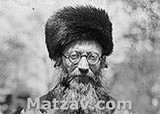 [Video below.] Rav Avrohom Yitzchok Kook, who lived from 1865 to 1935, was the first Ashkenazi chief rabbi of the British Mandate for Palestine, the founder of the Religious Zionist Yeshiva Merkaz HaRav, and a brilliant man and respected talmid chochom.
[Video below.] Rav Avrohom Yitzchok Kook, who lived from 1865 to 1935, was the first Ashkenazi chief rabbi of the British Mandate for Palestine, the founder of the Religious Zionist Yeshiva Merkaz HaRav, and a brilliant man and respected talmid chochom.
Rav Kook was born in Grīva, Latvia (now part of Daugavpils, then a town in Courland Governorate of Imperial Russia) in 1865, the oldest of eight children. His father, Rav Shlomo Zalman Hacohen Kook, was a talmid of the Volozhiner Yeshiva, while his maternal zaida was a member of the Kapuster chassidus.
As a child, Rav Avrohom Yitzchok gained a reputation of being an illui. He entered the Volozhiner Yeshiva in 1884 at the age of 18, where he became close to the rosh yeshiva, Rav Naftali Tzvi Yehuda Berlin, the Netziv. Although he stayed at the yeshiva for only a year and a half, the Netziv was quoted as saying that if the Volozhiner Yeshiva had been founded just to educate Rav Kook, it would have been worthwhile. During his time in the yeshiva, he learned some 18 hours a day.
In 1886, Rav Kook married Batsheva, the daughter of Rav Eliyahu David Rabinowitz-Teumim, better known as the Aderes, the rov of Ponevezh and later Chief Ashkenazi Rabbi of Yerushalayim.
In 1887, at the age of 23, Rav Kook entered his first position as rov of Zaumel, Lithuania. In 1888, his wife passed away and his father-in-law convinced him to marry her cousin, Raize-Rivka, the daughter of the Aderes‘ twin brother. In 1895, Rav Kook became the rov of Bausk.
Between 1901 and 1904, he published three articles which anticipated the fully-developed philosophy which he developed in Eretz Yisroel. During these years he wrote a number of works, most published posthumously, most notably a lengthy commentary on the aggados of mesechtos Brachot and Shabbos, titled ‘Eyn Ayah,’ and a brief sefer on morality and spirituality titled ‘Mussar Avichah’.
In 1904, Rav Kook moved to Ottoman Palestine to assume the post of rov in Yaffo, which also included responsibility for the new mostly secular Zionist agricultural settlements nearby. His influence on people in different walks of life was already noticeable, as he engaged in kiruv, thereby creating a greater role for Torah and halacha in the life of the city and the nearby settlements.
The outbreak of the First World War caught Rav Kook in Europe, and he was forced to remain in London and Switzerland for the remainder of the war.
In 1916, he became rov of the Spitalfields Great Synagogue, Machzike Hadas, an immigrant frum community located in Brick Lane, Whitechapel. Upon returning, he was appointed the Ashkenazi Rabbi of Yerushalayim, and soon after, as first Ashkenazi Chief Rabbi of Palestine in 1921. Rav Kook founded a yeshiva, Mercaz HaRav Kook, in Yerushalayim in 1924. He was a master of halacha. His unusual openness to new ideas drew many religious and nonreligious people to him. He wrote prolifically on both halacha and machshava, and his seforim and personality continued to influence many even after his petirah in Yerushalayim in 1935.
Rav Kook built bridges of communication and political alliances between the various Jewish sectors, including the secular Jewish Zionist leadership, the Religious Zionists, and more traditional non-Zionist Orthodox Jews. He believed that the modern movement to reestablish a Jewish state in Eretz Yisroel had profound theological significance and that the Zionists were agents in a Heavenly plan to bring about the messianic era. Per this ideology, the youthful, secular and even anti-religious Labor Zionist pioneers, chalutzim, were a part of a grand Divine process whereby the land and people of Israel were finally being redeemed from the 2,000-year golus by all manner of Jews who sacrificed themselves for the cause of building up the physical land, as laying the groundwork for the ultimate spiritual messianic redemption of world Jewry. He once commented that the establishment of the Chief Rabbinate was the first step towards the reestablishment of the Sanhedrin.
Many gedolim disagreed with Rav Kook’s ideology. While building bridges with mainly anti-religious elements, his ties with the traditional original frum kehillos were largely severed.
Rav Kook was critical of the secularists on certain occasions when they went “too far” in desecrating the Torah, for instance, by not observing Shabbos or kashrus. Rav Kook also opposed the secular spirit of the Hatikvah anthem, and penned another anthem with a more religious theme entitled HaEmunah.
Rav Kook had three children through his two wives: two daughters and a son, Rav Tzvi Yehuda Kook.
Click below to view a video about Rav Kook’s life:
[media id=140 width=400 height=300]
{Note: Views expressed in the video do not necessarily reflect the views of this site.}
{Dovid Bernstein-Matzav.com Newscenter}












“While building bridges with mainly anti-religious elements, his ties with the traditional original frum kehillos were largely severed.”
This seems misleading. Rav Kook still had much of the frum oilom with him. The fact that his opponents were and are very vocal should not obscure the fact that he enjoyed/enjoys much support and broad respect.
Rav Kook ZT”L was Rav Eliashiv’s mesader kiddushin.
#1, note the word “largely” (in “his ties with the traditional original frum kehillos were largely severed”). You can’t argue with that one.
#2 when was Rabbi Elyashiv shlita married?? 80+ years ago? Perhaps almost 90 years (yes he married young and is over 100). Then most of the issues had yet to occur (primarily in the 20s and 30s). So your point may or may not be relevant…..
#4 – Sorry, good try, but no cigar. The ‘issues’ were already out in the open when Moreinu Rav Elyashiv had chassunah.
Rav Elyashiv reveres Rav Kook zt”l. There was a guy working for a certain mossad who didn’t respect Rav Kook properly and I believe he was fired with the haskomo of Moreinu.
Lihavdil bein chaim….Moreinu Rav Shlomo Zalman Auerbach zt”l also revered Rav Kook zt”l, as did and do other gedoilei oilom.
and what is your source that rav elyashiv had him as mesader kiddushin? Out of thin air, like the signatures on the aschalta degeulah letter?
Plus, the more controversial statements he made were not known at that time. The vegetarianism, rembrandt, soccer players quote, and others were said later; writing articles about living in eretz yisroel was not that big of a deal(who knows if he even wrote about a state in those articles?); plus, you can’t judge rav elyashiv by his actions at..16? Rav Hutner was, in fact, a talmid of rav kook’s, but he famosuly removed his picture from his sukkah later on, and he never mentioned him in shiur.
He did sever himself from most of the oilam. Why do you think out of his numerous seforim, and the seforim of his talmidim, none of them – not one – is used anywhere except religious zionist yeshivos? Why doesnt the mirrer, ponevezh, chaim berlin, torah vodaas, brisk, BMG, or any other major yeshiva use his seforim? It’s sort of like how there are people who try to say that reb yoshe ber was accepted by klal yisroel – and then they have to wonder why in most yehsivos, say, rav shach and reb moshe is learned in shiur all the time, but rav yoshe ber is only menitoned in yeshivos run by his talmidim and religious zionist yeshivos; it just doesn’t fly.
Hey Matis, Rav Kook’s sefarim aren’t learned in “mainstream” yeshivas for the same reason that gedolim like Rav Yoel Teitlebaum zt”l and the Shulchan Aruch HaRav (the Baal Hatanya) aren’t learned. They’re a different hashkafa than the yeshivas you mentioned. That doesn’t mean they aren’t still held in very high esteem.